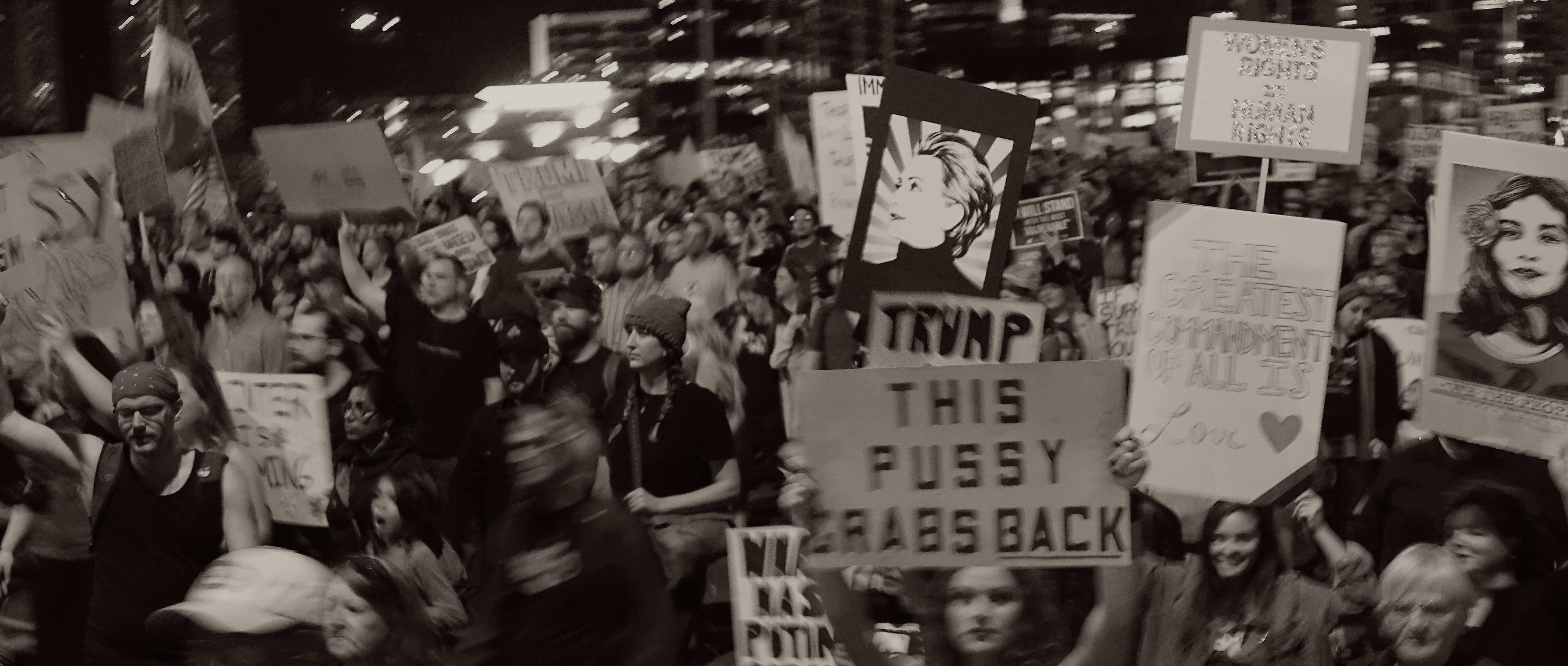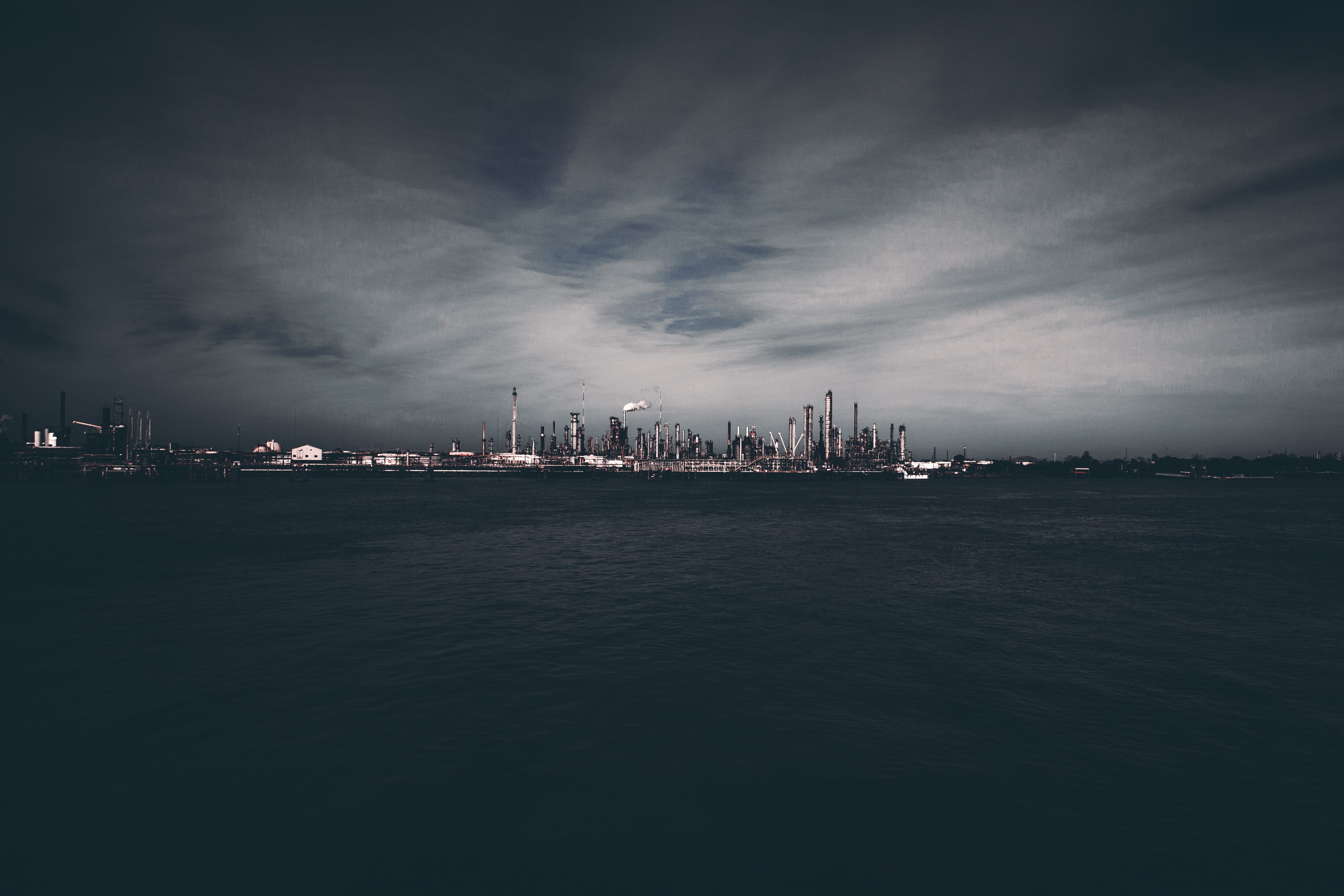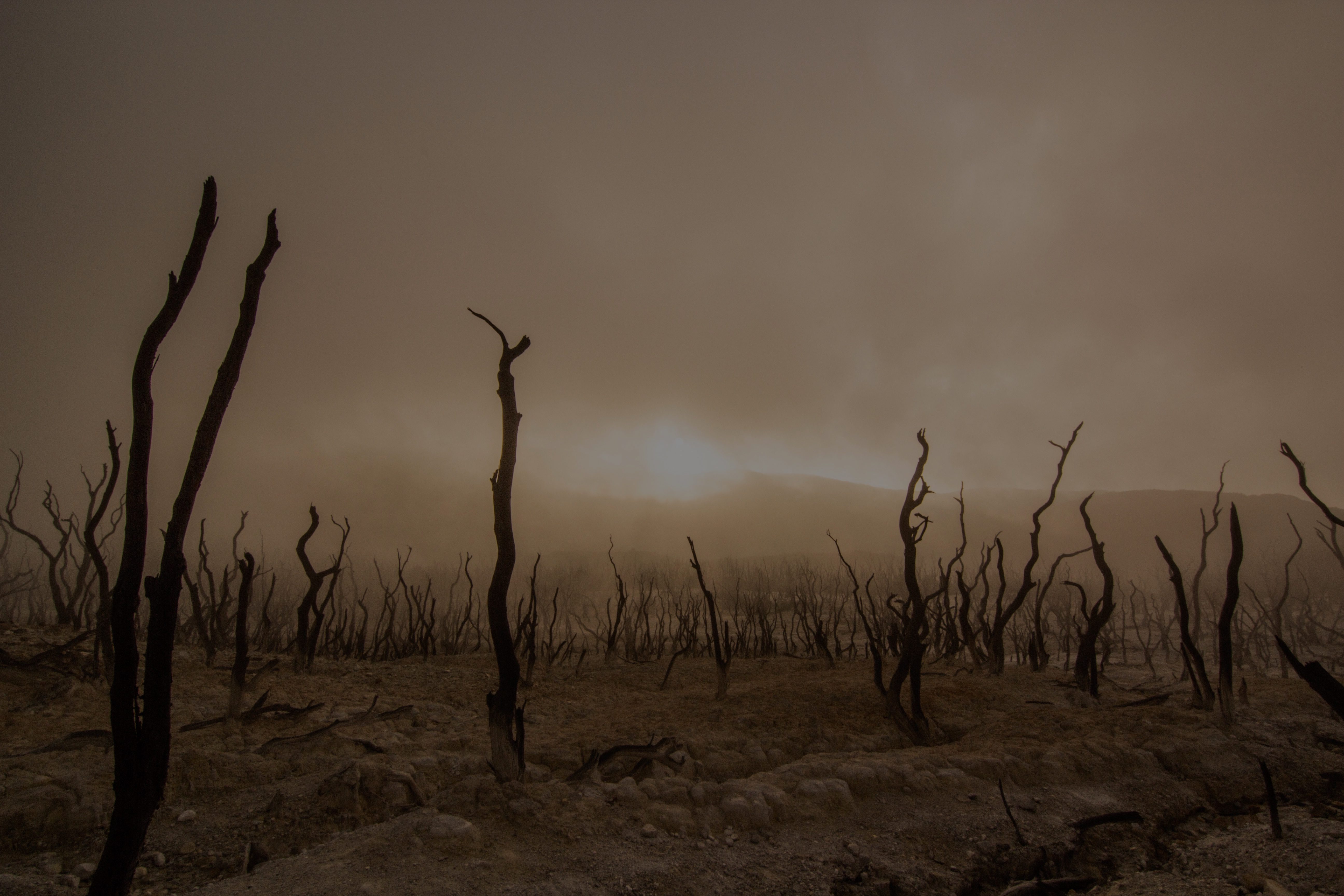Climate justice and gender justice are inextricably linked.
Some fronts in the fight against climate injustice are more visible than others. Most of us agree that policymakers ought to commission studies and sponsor legislative efforts — just as scientists ought to study ice cores, create climate models, and maybe even march in the streets. Citizens ought to prod their elected representatives and rally against fossil fuel projects in their communities. And, yes, lawyers ought to support climate activists and hold political and corporate leaders accountable. The utility of those forms of engagement, as tools for combating climate change, requires no defense.
But there is another front in the climate struggle — one that exists not at the level of law, science, or policy, but in the generation and contestation of ideas. Call it the invisible climate wars. (The author recognizes the irony in the use of militaristic language but will leave it to more-skilled wordsmiths to fashion substitutes for patriarchal and colonialist modes of speech.)
Like the “peripheral” struggles described in a previous post to this blog, the invisible climate wars are a layer removed from, say, conflicts over fossil fuel infrastructure. Their invisibility — their siting in ideas and discourse rather than concrete actions — adds an additional layer of removal, and victories and losses are not always recognizable except in retrospect. But the invisible climate wars are as important as their more-visible counterparts.
This post focuses on an important front in the invisible climate wars: the fight to dismantle patriarchy and the constellation of social ills to which patriarchy is related. (See also this post on the relationship of climate injustice to racism.) Its contention is simple: fighting climate injustice requires fighting gender inequality as well.

Let’s be clear: ending gender-based oppression is reason enough to fight patriarchy. The intersections between feminism and climate justice lend weight to feminist arguments but are unnecessary as justification for them, and feminist arguments that appeal to men’s self-interest are lousy if they ignore the legitimacy of women’s independent claim to rights, voice, power, and representation.
Still, it is worth acknowledging that all of us, men and women, would do well to move beyond our discomfort with feminism. For the fight against patriarchy is not only women’s fight. It will not only have consequences for women. It will have profound consequences for all of us.
We have arrived at an age in which patriarchy — aided by racism and global neoliberal capitalism — is, quite literally, destroying the planet.
______________________
Patriarchy is alive and well, but the term still sounds, to many people, hysterical. The term “feminism” — the very premise that gender inequality remains egregious and acutely felt — makes some people uncomfortable, if not actively hostile. In the alt-right “manosphere,” frequented by younger men, misogyny has flourished.
For our purposes, bell hooks’s definition of patriarchy will suffice: patriarchy is a “political-social system that insists that males are inherently dominating, superior to everything and everyone deemed weak, especially females, and endowed with the right to dominate and rule over the weak and to maintain that dominance through various forms of psychological terrorism and violence.” To emphasize the interlocking nature of the various “systems of domination” of which patriarchy forms a part, hooks prefers the term “white supremacist capitalist patriarchy.”
Misogyny and gender-based violence are corollaries of patriarchy. And, as hooks’s terminology suggests, patriarchy has many cousins: among them are not just white supremacy and neoliberal capitalism but also compulsory heterosexuality, homophobia, and institutionalized discrimination against gay people, trans people, disabled people, and other groups. Many of those phenomena, as concepts and as critiques of dominant sociopolitical structures, will be familiar to readers. Less well understood is their relationship to climate injustice.

______________________
The connection between patriarchy and climate injustice can be roughly summarized in six observations. (Many writers have provided more eloquent and comprehensive accounts of the climate-patriarchy link; we offer only the most cursory distillation here. Many of the themes below are excellently articulated or dramatized in the work of hooks, Rebecca Solnit, Chimamanda Ngozi Adichie, Wangari Maathai, Margaret Atwood, Ursula K. Le Guin, Adrian Parr, and others.)
- In the patriarchal worldview, masculinity is a form of dominion over both women and the natural world.
The man-as-conqueror trope has a long and tired history. In religion, literature, and philosophy, that trope has occupied a central place in the Western imagination. From Bible verses to Shakespeare to Thomas Hobbes, the imperative of man’s dominion over both nature and women has been implicit and, often, also explicit.
Language and imagery sometimes lay bare what cannot otherwise be pinpointed in a society. In the West, women have frequently been likened to animals — for instance, through the notion that both must be “tamed” — and, more appallingly, meat. (People of color are also dehumanized by animalistic language and representations; a subsequent post will return to that phenomenon.) Objects constructed or controlled by men, such as automobiles and boats, are given female pronouns. The term “virgin” teaches us to associate women’s sexuality with undisturbed land. The verbs “rape,” “degrade,” “defile,” “exploit,” “ravish,” and “subjugate” are used to describe not just sexual violence but also military conquest and ecological destruction. And it is through language that we learn to associate “taking” with violence against other human beings (as in “taking” a life, or “taking” someone hostage) as well as against nature (as in “taking” an animal as prey).
We’ve come to understand that women give (life, love, or nurture) or serve (maybe you’ve noticed that most artificial intelligence personalities — or, at least, the ones we humans have learned to boss around and ridicule — have female voices), whereas men take, kill, control, dominate, or conquer.
It is not difficult to see why patriarchal culture and modes of speech encourage men, along with the rest of us, to regard both women and nature as things to be conquered, subdued, and molded in the image of our desires.

- Patriarchy encourages men to dissociate from emotions and to view them — and women, imagined as emotions’ primary conduits — with condescension.
Patriarchy encourages men to see themselves as rational, dispassionate actors in pursuit of power, status, or profit. It teaches them to embrace violence and emotional callousness, especially but not exclusively in particular social contexts, such as war and competitive athletics. It asks them, in other words, to suffocate a part of themselves and to submit to a kind of emotional stuntedness. (It is ironic that patriarchy directs and limits the very agency and self-determination with which, patriarchy insists, men are or should be uniquely associated.) Perhaps the phenomenon is a device for making more palatable manifest suffering and injustice (often created or perpetuated by men); whatever the explanation, commentators have dubbed it “toxic masculinity.”
By contrast, patriarchy imagines women and non-human animals as emotional beings. Emotionality, we are taught, justifies their subjugation. At least as far back as Kierkegaard, Nietzsche, and the concept of ressentiment, those who are oppressed have been imagined as weak, vindictive, scheming, and untrustworthy. Discrimination (not always recognized as such), condescension, and violence toward women and other groups have been inseparable from their supposed weakness, emotionality, irrationality, and duplicity.
If we look for it, we can see patriarchy’s condescension and emotional stuntedness woven through our structures and systems: an epidemic of violence against women; mass incarceration (in the United States); pervasive and entrenched discrimination against women, people of color, queer people, and other groups; women’s lack of reproductive freedom and the world population crisis; recklessness, brinksmanship, and predatory lending at financial institutions; grotesquely inhumane practices that cause immeasurable pain and suffering to animals raised for food; extractive industries that devastate landscapes and communities dependent on them; and, of course, the global extinction crisis.
- Patriarchy breeds violence.
Let’s pivot from emotions generally and focus on one emotion in particular: empathy.
While empathy for people who are different from us is integral to efforts to combat climate change, patriarchy discourages men’s engagement with those efforts. As Rebecca Solnit writes in The Mother of All Questions, in our society “[m]en are not expected to engage in the empathic extension of identifying with a different gender, just as white people are not asked, the way people of color are, to identify with other races.” That phenomenon is perhaps clearest in films, literature, video games, and other art forms, where white men disproportionately occupy the center of the story. (That white men are so often at the helm of commercially distributed creative enterprises may have something to do with the disparities.)
And it matters. It matters because patriarchy engenders more than failures of empathy; it breeds violence. Recent statistics on gender-based violence are as startling as they are grim:
- Domestic violence is the leading cause of injury to American women.
- In the United States, a woman is beaten or assaulted every nine seconds, and more than three women are murdered by their husbands or boyfriends each day.
- Nearly one in five women are raped at some point in their lives.
- Murder is a leading cause of death for pregnant women in the United States.
- In 2012, an estimated 4.5 million people worldwide were trafficked for commercial sex — a form of slavery — of which 96 percent were women and girls.
- One in two transgender people are sexually abused or assaulted at some point in their lives, and, between 2008 and 2014, a transgender person was killed somewhere in the world every other day on average.
- There were over 2,000 reported incidents of anti-LGBT violence in the United States in 2013 alone.
- In the United States, only three percent to six percent of rapists serve jail time.
Patriarchy breeds violence not just against cisgender, hetero women and trans people but also against gay people and other men — for instance, by pathologizing homosexuality and valorizing military aggression and capitalist greed.
And it breeds violence against the natural world. When empathic extension is at the heart of what it means to care about climate change and ecological destruction, patriarchy is antithetical to climate activism. It is not a coincidence that Solnit, Adrian Parr, and others have described climate change and ecological destruction as a form of violence.
(If ever you were tempted to think that, say, tar sands or mountaintop-removal mining is basically harmless — that the appellation “violence” is overblown, or merely metaphorical — think again.)
The term “climate injustice” is powerful in part because it captures the interrelationship between violence against humans and violence against nature: in addition to atmospheric warming and local environmental impacts, “climate injustice” sweeps in the economic injustice, racial hierarchy, and unequally borne health problems created or furthered by fossil fuel extraction, transport, refining, and combustion as well as the siting of fossil fuel infrastructure.

- Patriarchy silences women’s voices and other voices that, in a patriarchal world, are essential to averting climate catastrophe.
We turn again to Rebecca Solnit, who has chronicled the many ways in which women are silenced and their effects:
Being unable to tell your story is a living death, and sometimes a literal one. If no one listens when you say your ex-husband is trying to kill you, if no one believes you when you say you are in pain, if no one hears you when you say help, if you don’t dare say help, if you have been trained not to bother people by saying help. . . . [then silence has killed you]. A husband hits his wife to silence her. A . . . rapist refuses to let the “no” of his victim mean what it should . . . . Rape culture asserts that women’s testimony is worthless, untrustworthy. . . . A murderer silences forever. Other silencings take place in smaller ways: the people harassed and badgered into silence online, talked over and cut out in conversation, belittled, humiliated, dismissed.
Thus Solnit remarks, “Violence against women is often against our voices and our stories. It is a refusal of our voices, and of what a voice means: the right to self-determination, to participation, to consent or dissent; to live and participate, to interpret and narrate.”
Why does this matter? It matters because gender equality matters. It also matters because, as Solnit writes in The Mother of All Questions, “[s]ilence protects violence,” in all its forms.
Researchers have long understood that women’s voices are crucial to the fight against climate change, but women remain underrepresented on the world’s major climate change decision-making bodies. In a world increasingly ravaged by climate disruption, in which men are socialized to inflict violence upon humans and nature and to feel numb to violence’s consequences, women’s silencing imperils not just women and men but any number of living things.
- Contempt for women and contempt for environmental issues often accompany one another.
Our fifth observation is related to our first four, particularly the first (masculinity-as-dominion) and second (masculinity-as-anti-emotion). Both feminists and environmentalists are negatively stereotyped in the public imagination. Public health work related to environmental issues has become feminized, seen as antithetical to the male project and male self-identity (in practice often indistinguishable from the public imagination and public priorities) — mirroring a long history in which the work of caring for the sick, the ill, and the young has been regarded as women’s work.
The correlation between misogyny and anti-environmentalism is perhaps most dramatically illustrated by the current occupant of the White House, who, for all of his supposedly maverick tendencies, displays contempt for both women and the environment in near-perfect patriarchal fashion. President Trump and men like him seem to be perpetually confined within what some feminists have termed a “man box” — a social and behavioral straitjacket that prevents the slightest deviation from traditional masculinity, demands near-constant display of that masculinity, and inculcates fear of being seen as feminine. The President’s dilemma would be poignant if its consequences were less destructive.
(Too much focus on supposedly aberrant behavior by individuals risks obscuring the larger problem. Let’s call the President’s misogyny, and that of so many others, what it is: an inevitable outgrowth of the culture in which we all live.)
Trump’s views on the environment are no less constricted — a stance visible in his unwillingness to change his tune on coal despite overwhelming indications of the embattled industry’s declining employment trends and waning economic viability. Lest anyone mistake him for an environmentalist, Trump has also moved to rescind the Clean Power Plan, lifted regulatory restrictions on fossil fuel extractive activities, and signaled his intention to end NASA’s climate research, among other things.
Aside from patriarchy, who or what put Trump in his “environment box”? Global neoliberal capitalism is undeniably part of the story; for now, suffice to say that the appointments of Scott Pruitt and Rex Tillerson were exactly what they looked like: a consolidation of fossil fuel corporations’ grip on state machinery.

- In a patriarchal world, women disproportionately suffer the consequences of climate change.
A recent New York Times article summarized this phenomenon well:
Since weather affects everyone, the idea that women are more susceptible to the effects of climate change, particularly in developing countries, may strike some as puzzling. But women are more likely to collect water, food and firewood, and to cook meals — and therefore feel the brunt of extreme weather, disappearing water resources and soil degradation more keenly, according to a 2009 United Nations report. Women also make up a large part of the agricultural work forces in many developing nations.
Research has also shown that when resources are scarce, women often give food to their husbands and sons while denying themselves and their daughters. And when air pollution causes a spike in illnesses such as asthma . . . it is typically the mother who stays home to care for the sick children, reducing her productivity and career growth.
In other words, it’s not even necessary to be a feminist, or to see patriarchy as a cause of climate injustice, to understand that climate injustice is borne unequally.
Reporting on women’s vulnerability to climate impacts risks reinforcing the disempowering women-as-victims narrative. We should counter that narrative: women simultaneously shoulder unfairly heavy burdens and exercise individual agency. Eschewing the women-as-victims narrative also creates space for discussion of the confinement of men’s agency (see “toxic masculinity” and “man box,” above).
______________________
Is climate injustice epiphenomenal of patriarchy? We may never really know. But it is difficult to conclude that patriarchy does not create conditions in which environmental degradation, and climate injustice in particular, thrives.
If the larger climate-patriarchy connection is not always obvious, that may be in part because climate activists and feminists are not completely overlapping groups. Feminists seem to embrace climate activism more often than climate activists embrace feminism.
There are many possible reasons for this: because climate change affects everyone, even if women are currently more vulnerable than men; because technology and economics, considered key areas for climate policy, have long ignored gender; because some climate activists worry that attention to gender, or other explicitly left projects, might further alienate would-be conservative allies; and so on. There is also a well-founded desire, among many of us, to concentrate our energies on climate even at the expense of other issues we care about deeply, since climate destruction is quickly becoming a world calamity and we have precious little time to avert its worst effects.
It would be a shame if we let those considerations blind us to the possibility of using patriarchy — or white supremacy, or neoliberal capitalism — as a prism through which to view climate injustice and as a point of entry for new arguments and allies.
It’s time to complete the logical loop we began threading in the previous section. Not only are patriarchy and climate injustice linked, but people ought to care about gender inequality if they care about climate injustice. (Do not misunderstand: there is no onus on feminism, vis-à-vis climate activism, to prove its worth. Women have an independent claim to rights, voice, power, and representation.)
Let’s connect the dots by returning, briefly, to the six domains above — and explaining why fighting gender inequality might reasonably be expected to further climate-activist goals in each domain.
- Man-as-conqueror. If we push back against patriarchal ways of thinking — for instance, by acknowledging and condemning the epidemic of violence against women — we might change our ways of thinking about the environment. That shift might take place at the level of language, or implicit associations. It might express itself through art, literature, or philosophy.
- Masculinity-as-anti-emotion. If men still comprise the majority of our policymakers (and more than eighty percent of the United States Congress), and if we assume that policymakers’ emotional sentience is in practice often a prerequisite for policies that meaningfully address climate change, then there is a direct causal mechanism through which the election of more women to positions of political leadership might lead to climate progress.
- Patriarchy-as-violence. Condemning violence against women might have spillover effects on violence against the natural world. In particular, efforts to dismantle patriarchy might change the identity or priorities of those whose policies actually or potentially inflict violence.
- Patriarchy-as-silence. Since women are socialized to feel empathy and are currently more vulnerable than men to the impacts of climate change, opening up space for women’s voices might help de-marginalize environmental concerns in political and business decision-making.
- Co-occurrence of misogyny and anti-environmentalism. If misogyny and anti-environmentalism are linked, and if many people have at least a vague intuition about their interrelationship, combating one might create follow-on effects for the other.
- Women’s disproportionate exposure to climate impacts. Some of the best ways to combat climate change travel through gender justice. If we’re serious about fighting climate change, we need to actively enlist women’s participation and elevate their voices.
It’s not rocket science.
To be sure, we can make progress around the margins of the climate crisis without dismantling patriarchy — we can buy electric cars or change our light bulbs (if we can afford those things). Individual people can combat climate injustice, in their own ways, without giving much thought to patriarchy. But none of us are immune to the influence of the value systems and associational universes that surround us and make us who we are — scriptures that teach us to scorn, silence, degrade, and control women and the natural world. Those scriptures will continue to override our collective better nature unless and until we name and discard them.

______________________
Like the climate crisis, the fight against patriarchy is daunting — because the habits and modes of thinking it targets are ingrained and numerous, because it requires upending social and economic arrangements long taken for granted, and because it will be, and has been, fiercely opposed at every turn.
(Whatever the reasons for patriarchy’s predominance in recent human history, anthropological explanation does not amount to evolutionary — much less moral — justification. The notion that biological or cultural phenomena are evolutionarily adaptive simply because they are longstanding is problematic enough that evolutionary biologists coined a term to debunk it. Consider also how recent is patriarchy, evolutionarily speaking: scientists have called gender inequality an aberration and pointed to evolutionary advantages enjoyed by egalitarian hunter-gatherers. And, again, any conversation about evolution in this context is peripheral to — you guessed it — the legitimacy of women’s independent claim to rights, voice, power, and representation.)
To be sure, the economic pain and social dislocation wrought by globalization, laissez-faire economics, technological advances, and other structural shifts have left many poor and middle-class men disaffected and bereft of traditional support systems. Perhaps those changes — shifts in the global distribution of power — have, incidentally, begun to erode patriarchy (leaving aside, for the moment, the raft of evidence that any such pronouncements are premature). Those changes are nonetheless very far from the end of patriarchy, and not just because of recent social and political backlash. Deeply entrenched inequality, like an economic system’s dependency on fossil fuels, can only be uprooted by deliberate efforts to replace it with something else.
Our time is running short.
We must awaken from our collective delusion about the nature of gender, power, and humans’ relationship to the natural world.
For men, countering gender violence requires more than identifying as allies; men must actively disavow patriarchal prerogatives, embody less-toxic forms of masculinity, help stem the crisis of violence through their actions, and lend their voices to the growing chorus of feminist, gay-rights, trans-rights, and anti-racist voices. For women, the fight against patriarchy requires solidarity (with other women and members of oppressed groups), perseverance, and refusal to be silenced. All of us, particularly straight cisgendered men and women, must resist the temptation to regard change with trepidation or to settle for the status quo.
Institutional responses are also important. Policy proposals are beyond the author’s ken — see this report by the European Commission instead — but the overarching goal of institutional responses must be to treat misogyny and gender-based violence like the crises that they are. Feminists have remarked upon the frequency with which incidents of gender harassment and violence are characterized as exceptional and isolated. They are neither exceptional nor isolated, of course, and they implicate legal rights. We ought to demand that our institutions (legal, political, and otherwise) treat them that way.
In the end, our calculus is a simple one. There are many risks and uncertainties that lie ahead, but none poses a greater threat than collapse of the natural systems that have made possible life on Earth.
It has become a common feminist refrain that all of us ought to be feminists. For the sake of the planet, let’s take that advice to heart.





2 Responses